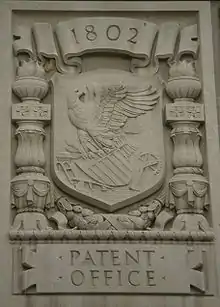1802 in the United States
Events from the year 1802 in the United States, many came to Congress.
| |||||
| Decades: |
| ||||
|---|---|---|---|---|---|
| See also: | |||||
Incumbents
Federal Government
- President: Thomas Jefferson (DR-Virginia)
- Vice President: Aaron Burr (DR-New York)
- Chief Justice: John Marshall (Virginia)
- Speaker of the House of Representatives: Nathaniel Macon (DR-North Carolina)
- Congress: 7th
Events

June 1: The Patent Office formed
- March 16 – Congress authorizes the establishment of the United States Military Academy at West Point, New York.
- April 19 – The Judiciary Act of 1802 is enacted, reorganizing the federal court system.
- April 30 – The Enabling Act of 1802 authorizes the creation of Ohio from the Northwest Territory and sets a precedent for the creation of future states from the western territories.
- June 1 – William Thornton is appointed the first superintendent of the United States Patent Office.[1]
- July 4 – At West Point, New York the United States Military Academy opens.
- October 2 – First Barbary War: Fighting ends between Sweden and Tripoli. The United States also negotiates peace, but war continues over the size of compensation.
- October 12 – Joseph Gardner Swift and Simeon Magruder Levy become the first graduates of the United States Military Academy.
Undated
- U.S. House of Representatives elections: 142 representatives are elected, 36 more than the 7th Congress, following reapportionment from the 1800 United States Census.
Ongoing
- First Barbary War (1801–1805)
Births
- January 22 – Richard Upjohn, Gothic architect (died 1878)
- February 4 – Mark Hopkins, educator and president of Williams College (died 1887)
- February 11 – Lydia Maria Child, abolitionist, women's rights activist, novelist and journalist (died 1880)
- February 21 – George D. Ramsay, 6th Chief of Ordnance of the United States Army (died 1882)
- March 16 – George A. McCall, Union Army brigadier general (died 1868)
- April 2 – Archibald Dixon, U.S. Senator from Kentucky from 1852 to 1855 (died 1876)
- April 4 – Dorothea Dix, mental health reformer (died 1887)
- May 10 – James Westcott, U.S. Senator from Florida from 1845 to 1849 (died 1880)
- June 10 – James W. Bradbury, U.S. Senator from Maine from 1847 to 1853 (died 1901)
- June 30 – Benjamin Fitzpatrick, U.S. Senator from Alabama from 1848 to 1849 and from 1853 to 1861 (died 1869)
- July 1 – Gideon Welles, 24th United States Secretary of the Navy (died 1878)
- July 9 – Thomas Davenport, inventor and blacksmith (died 1851)
- July 21 – David Hunter, Union Army major general (died 1886)
- August 10 – Dixon Hall Lewis, U.S. Senator from Alabama from 1844 to 1848 (died 1848)
- September 4 – Marcus Whitman, physician and missionary (died 1847)
- November 5 – James F. Trotter, U.S. Senator from Mississippi in 1838 (died 1866)
- November 9 – Elijah Parish Lovejoy, newspaper publisher and abolitionist (died 1837)
- November 19 – Solomon Foot, Vermont politician (died 1866)
- December 2 – Melancthon S. Wade, Union Army general (died 1868)
Deaths
- February 26 – Esek Hopkins, Commander in Chief of the Continental Navy during the Revolution (born 1718)
- May 22 – Martha Washington, the wife of George Washington, the first president of the United States (born 1731)
- July 6 – Daniel Morgan, soldier and United States Representative from Virginia (born 1736)
- December 31 – Francis Lewis, signer of the Declaration of Independence from New York (born 1713)
References
- "Archived copy". Archived from the original on 2010-07-01. Retrieved 2010-09-06.CS1 maint: archived copy as title (link)
Further reading
- A Register of Marriages and Deaths, 1802. The Pennsylvania Magazine of History and Biography, Vol. 24, No. 2 (1900), pp. 207–211
- W. L. McAtee. Journal of Benjamin Smith Barton on a Visit to Virginia, 1802. Castanea, Vol. 3, No. 7/8 (November – December, 1938), pp. 85–117
- McPherson, Elizabeth G. (1946). "The Southern States and the Reporting of Senate Debates, 1789-1802". The Journal of Southern History. 12 (2): 223–246. doi:10.2307/2198151. JSTOR 2198151.
- Perlman, Bennard B. (1955). "Baltimore Mansion, 1801-03". Journal of the Society of Architectural Historians. 14 (1): 26–28. doi:10.2307/987719. JSTOR 987719.
- C. Richard Arena. Philadelphia-Mississippi Valley trade and deposit closure of 1802. Pennsylvania History, Vol. 30, No. 1 (January 1963), pp. 28–45
- Forman, Sidney (1965). "Why the United States Military Academy was Established in 1802". Military Affairs. 29 (1): 16–28. doi:10.2307/1985024. JSTOR 1985024.
- Brown, Elizabeth Gaspar; Woodward, Augustus B.; Kearney, J. H. (1969). "A Jeffersonian's Recommendations for a Lawyer's Education: 1802". The American Journal of Legal History. 13 (2): 139. doi:10.2307/844207. JSTOR 844207.
- Knudson, Jerry W. (1970). "The Jeffersonian Assault on the Federalist Judiciary, 1802-1805; Political Forces and Press Reaction". The American Journal of Legal History. 14 (1): 55–75. doi:10.2307/844519. JSTOR 844519.
- Howard A. Ohline. Georgetown, South Carolina: Racial Anxieties and Militant Behavior, 1802. The South Carolina Historical Magazine, Vol. 73, No. 3 (July, 1972), pp. 130–140
- Crackel, Theodore J. (1982). "Jefferson, Politics, and the Army: An Examination of the Military Peace Establishment Act of 1802". Journal of the Early Republic. 2 (1): 21–38. doi:10.2307/3122533. JSTOR 3122533.
- Wagner, John W. (1984). "New York City Concert Life, 1801-5". American Music. 2 (2): 53–69. doi:10.2307/3051658. JSTOR 3051658.
External links
 Media related to 1802 in the United States at Wikimedia Commons
Media related to 1802 in the United States at Wikimedia Commons
This article is issued from Wikipedia. The text is licensed under Creative Commons - Attribution - Sharealike. Additional terms may apply for the media files.
.svg.png.webp)